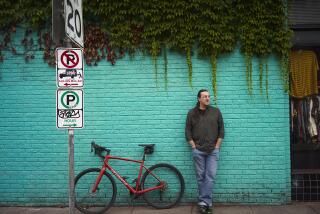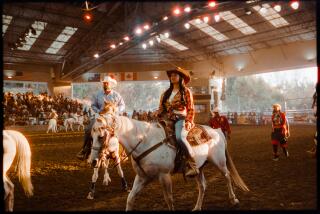Going Full Cycle : Biker Image, Especially in California, Has Undergone a Major Overhaul
- Share via
Like Rodney Dangerfield, motorcyclists would like a little respect. It’s tough to live down the bad-guy image that bikers have had for 40 years, but there are signs that things may be changing.
Middle-aged or retired couples, widows and widowers have taken to the road on what are called luxo-tourers, big luxury touring bikes that exude comfort and sport CBs, stereos, tape decks and intercoms. There are young motorcycling families with children riding in sidecars, and more and more businessmen, many dressed in suits and ties, commuting to and from work.
“I don’t think you’ve got the paranoia out there you used to have about bikers,” said Tom Jefferies, a 43-year-old truck driver who has been cycling for more than 20 years.
Jefferies lives in San Dimas and rides his bike daily to Van Nuys, where he works for the City of Los Angeles.
Whole Different Concept
“There’s a whole different concept to the biker image than there used to be,” he said. “You’ve got people from almost every vocation and income level touring around the country. There are truck drivers, doctors, lawyers, plumbers, carpenters. A lot more women. In the last five years, there’s been a really big turnaround with the motoring public about motorcycles.”
There also has been a vast increase in riders. In 1960, there were only half a million bikers. Now, there are more than 5 million. California leads the nation with 940,000 registered cycles, scooters and all-terrain vehicles, and Los Angeles and Orange are No. 1 and No. 2 counties in the country with a combined total of more than 300,000.
“These are people who like being as close to the environment as possible,” explained Steve Bransky, a Motorcycle Safety Foundation instructor. “You have more freedom than in a car and you need more skill to stay alive. It’s the challenge and the environment, openness and exposure. There’s a risk involved in anything you do.
“People who use them for commuting are those who want something more maneuverable than a car,” Bransky added. “You can keep moving, even if you’re only going six miles an hour.”
“There’s a certain independence in riding, getting away on a two-lane country road with the wind in your hair,” said Scot Hunter, a 45-year-old member of the local Golden State H.O.G. (Harley Owners’ Group) chapter who spent 20 years as a technical manager for ABC-TV. Hunter bought his first bike in 1981. He no longer owns a car.
Smelling the Environment
“When you ride through someplace in a car, you’re not in the environment,” Hunter continued. “You don’t come to a temperature pocket and feel the temperature drop 15 degrees or notice the smell of trees, mustard. You smell the environment, you feel it and you’re part of it. A motorcycle says you’re a free spirit.”
But being a cycling free spirit is not cheap. Motorcyclists spend anywhere from $3,000 for the smaller bikes to $10,000 and up for the large touring motorcycles fully equipped. Overall, motorcycle enthusiasts constitute a $963-million-a-year retail business nationwide on cycles, accessories, insurance, etc.
Some people have color-coordinated clothing, helmets and bikes. Others prefer to stick with their protective leather, the traditional black for Harley-Davidson riders, brighter colors for riders of other makes, particularly the fast sport bikes.
For every kind manufactured here, in Europe or Japan, there is a national motorcycle club with local chapters in the states. They have monthly rides, club rallies, hold yearly conventions and put out newsletters. Although they don’t make it a requirement, some clubs ask that their members wear helmets as a safety precaution.
Most motorcycle clubs are heavily in charity work, including Christmas toy drives for underprivileged kids, events to raise money for hospitals and the homeless, and an upcoming 100-mile Southern California ride to benefit muscular dystrophy.
And in carrying out some of these projects, there’s a lot of camaraderie and fun.
But Jefferies and other motorcyclists admit that the image of bikers as outlaws and thugs has been no joking matter, ever since that July 4, 1947, weekend in Hollister, near Santa Cruz, where the beer-guzzling, leather-jacketed lawless reputation was spawned during a biker gathering.
Marlon Brando’s portrayal of a violent biker in “The Wild One” in 1954 delivered another crippling blow to cyclists’ image, and in years past the Hells Angels’ nationwide reputation, fueled the outlaw branding of cyclists.
Still a Stigma
“There’s still a stigma attached to motorcycles,” said Dr. Steven Kane, a dentist in Westfield, N.J., who belongs to the Motorcycling Doctors Assn., a national group about 125 physicians, dentists, medical and dental students, veterinarians and podiatrists formed in 1976. “It’s hard to get people to believe motorcyclists are not Hells Angels anymore.”
The doctors’ club sponsors a three-day seminar in different cities around the country each year to present scientific studies on health-related motorcycle issues, treatment of injuries, protective clothing, equipment evaluations and motorcycle tests and a safety course.
“We deal with how to make the sport safer and change its image,” Kane explained. “But we’ve tried to advertise (the seminar) in the AMA and ADA professional journals and they haven’t allowed us so far. They aren’t really thrilled making known a group of motorcycling doctors.”
There have been other efforts toward safety. Bransky operates the Motorcycle Training Center in Los Angeles, the largest civilian training program in the United States. Since he started the courses in 1981, 6,000 bikers have completed beginning or advanced instruction at the Hollywood Bowl or Terminal Island.
There is currently no California law requiring motorcylists to take instructional riding courses before applying to the DMV for a license. But starting in January, cyclists between the ages of 15 1/2 and 18 must take a Motorcycle Safety Foundation (for course locations: (800) 447-4700) beginning riding course in addition to (automobile) driver education and training.
Although motorists complain about cyclists straddling freeway lanes between cars, the practice, called “sharing lanes” is legal.
“That’s part of the average motorists’ annoyance (with cycles),” Hunter said. “And in the case of young or old crazies zipping in and out of lanes, that’s a legitimate complaint. But I’d say 80% of the accidents that happen is the drivers’ lack of consciousness. Not being aware of the motorcycle. In motorcycle safety school, one of the first things they teach is that you (as a cyclist) are responsible for everything 360 degrees around you. The disadvantage of motorcycles is vulnerability.”
A Changing Image
Maturity plays a part in the new view of cyclers. The median age of the nation’s on-road bikers is 30; subscribers to one of the popular motorcycle magazines is 41.1.
“The image has changed. You can tell that on the road,” said Don Minchinton, 51, president of the South Coast BMW Riders of Orange County. Minchinton, a maintenance planner for McDonnell Douglas, and his wife, Sherry, tow a trailer on their motorcycle and tour across the United States and in Europe during their vacations. Their trailer, custom built by Minchinton and his son, makes into a bed with a tent over it.
“Some of these people riding today were guys who had that (Hells Angels) image, but they’ve grown up and gotten away from the stripped-down choppers,” he said. “We’ve talked to a lot of people on the road and they’re starting to realize that there is a lot of difference now. I take off my helmet and they see this bald head. Well, that’s not a Hells Angel image.”
The real Hells Angels, too, have tried to upgrade their public image with a positive public relations campaign in recent years. Some groups have donated blood en masse to the Red Cross, and funded anti-drug billboard campaigns. Others have raised money for various charities and held holiday toy drives.
“I don’t think there is so much outlaw stuff anymore,” said Silver Lake commercial illustrator Dick Johnson, who owns 10 motorcycles and trail rides with his 17-year-old son Chris, an off-road racer.
“There are guys who kind of dress the part and get out there on weekends, but some of them are pretty successful businessmen, professional people. They’re not what they seem to be,” he said.
Johnson and his son have already planned a cross-country ride to Pennsylvania for the summer of 1989, where the 51-year-old Johnson plans to attend his class reunion. “This is a good sport,” he said. “I don’t see myself ever quitting.”
As motorcyling grows, both as a recreation and a sport, national club rallies increase in popularity each year.
‘No Problems’
The Minchintons rode back east for the BMW Motorcycle Owners of America convention in Escanaba, Mich., this summer, which 6,000 members attended. “We had no problems there,” he said. “Not one ticket was given out. It’s a little town of 25,000 people and they welcomed us with open arms and were sorry to see us go.”
Three thousand people showed up for Rider magazine’s first rally last summer in Cody, Wyo., and Rider editor Tash Matsuoka says the rally was such a success that the magazine plans to make it an annual event. “I think the population of Cody has a new perception of motorcycling,” Matsuoka said, explaining that Rider appeals to an older cycling population, mostly made up of touring riders and people with sports bikes.
Nancy Wright, a 74-year-old great grandmother who began riding four years ago after her husband died, attended the Rider rally with friends from some of the seven riding clubs she belongs to in the San Francisco area. Wright, who has a fully-equipped Honda Gold Wing, has toured to Alaska and plans a European motorcycle jaunt next year.
“Some people wonder why I ride,” she said. “But then they wonder why I ski, too. My answer is you’ve jut got to keep active. I was taught to burn out, not rust out. . . . Recently the motorcycle world has pretty much occupied my life. There is a spiritual thing about it. It’s uplifting. You get an experience riding through the country that you never get in a car. Ride a motorcycle and you are master of yourself and master of your machine.”
More to Read
Sign up for Essential California
The most important California stories and recommendations in your inbox every morning.
You may occasionally receive promotional content from the Los Angeles Times.










